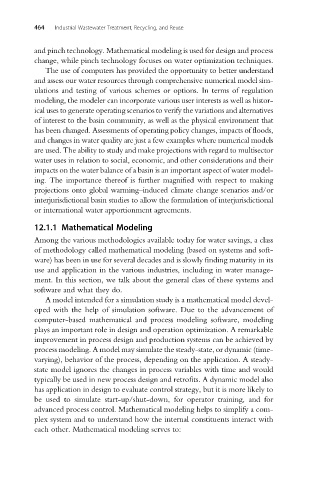Page 494 - Industrial Wastewater Treatment, Recycling and Reuse
P. 494
464 Industrial Wastewater Treatment, Recycling, and Reuse
and pinch technology. Mathematical modeling is used for design and process
change, while pinch technology focuses on water optimization techniques.
The use of computers has provided the opportunity to better understand
and assess our water resources through comprehensive numerical model sim-
ulations and testing of various schemes or options. In terms of regulation
modeling, the modeler can incorporate various user interests as well as histor-
ical uses to generate operating scenarios to verify the variations and alternatives
of interest to the basin community, as well as the physical environment that
has been changed. Assessments of operating policy changes, impacts of floods,
and changes in water quality are just a few examples where numerical models
are used. The ability to study and make projections with regard to multisector
water uses in relation to social, economic, and other considerations and their
impacts on the water balance of a basin is an important aspect of water model-
ing. The importance thereof is further magnified with respect to making
projections onto global warming–induced climate change scenarios and/or
interjurisdictional basin studies to allow the formulation of interjurisdictional
or international water apportionment agreements.
12.1.1 Mathematical Modeling
Among the various methodologies available today for water savings, a class
of methodology called mathematical modeling (based on systems and soft-
ware) has been in use for several decades and is slowly finding maturity in its
use and application in the various industries, including in water manage-
ment. In this section, we talk about the general class of these systems and
software and what they do.
A model intended for a simulation study is a mathematical model devel-
oped with the help of simulation software. Due to the advancement of
computer-based mathematical and process modeling software, modeling
plays an important role in design and operation optimization. A remarkable
improvement in process design and production systems can be achieved by
process modeling. A model may simulate the steady-state, or dynamic (time-
varying), behavior of the process, depending on the application. A steady-
state model ignores the changes in process variables with time and would
typically be used in new process design and retrofits. A dynamic model also
has application in design to evaluate control strategy, but it is more likely to
be used to simulate start-up/shut-down, for operator training, and for
advanced process control. Mathematical modeling helps to simplify a com-
plex system and to understand how the internal constituents interact with
each other. Mathematical modeling serves to:

